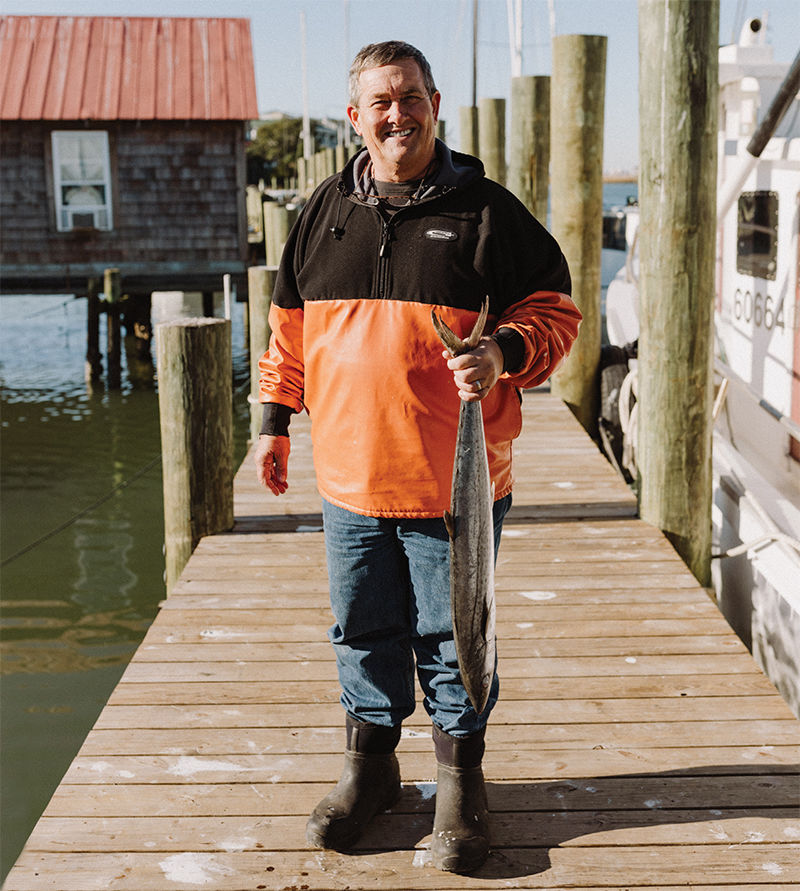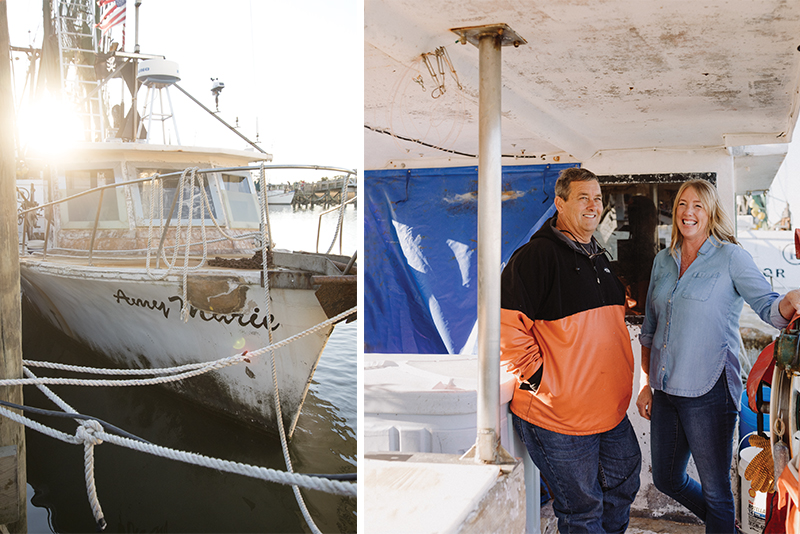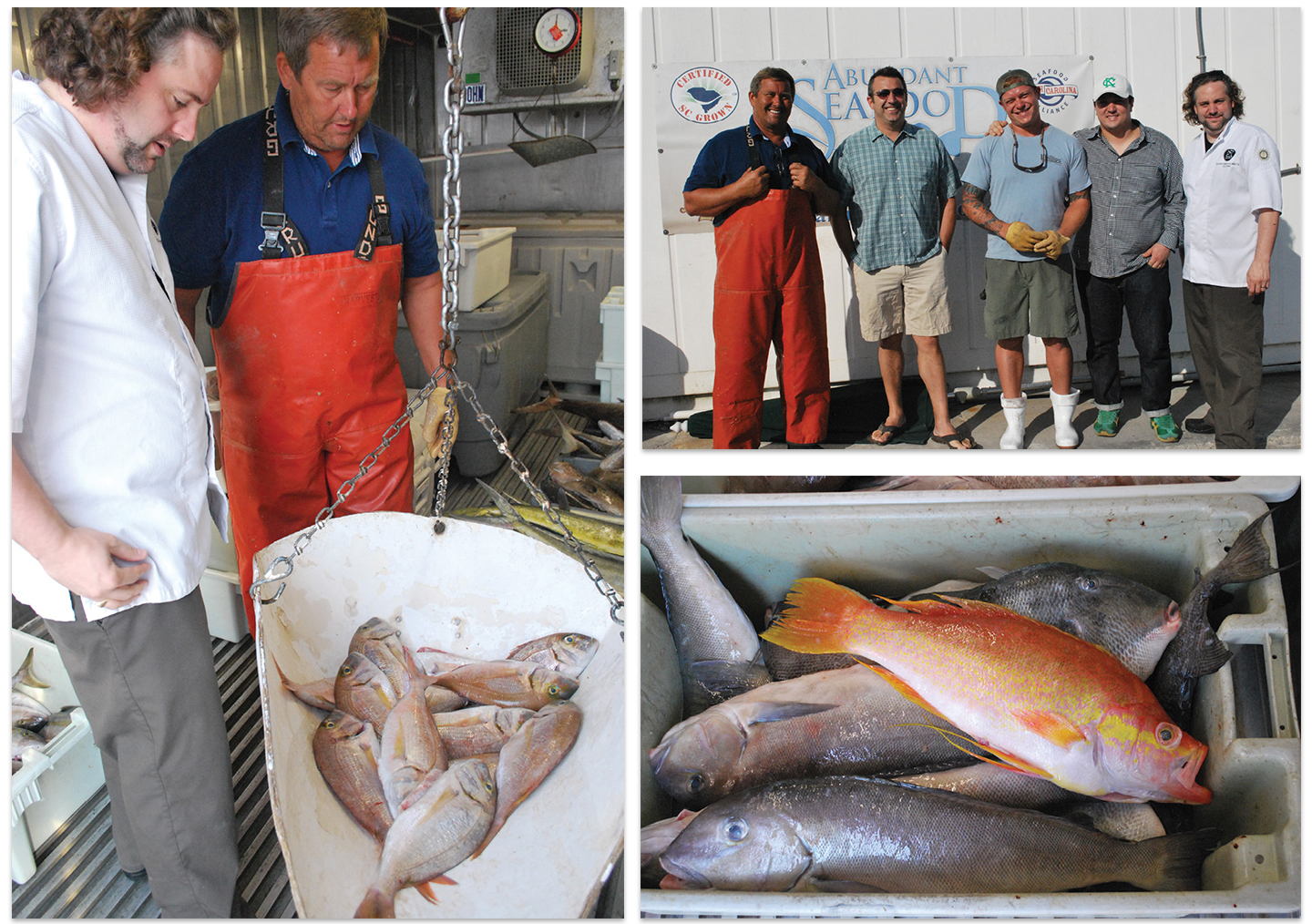After years of catching a diverse array of fish for the city’s finest restaurants, the sustainable seafood champion is sharing the bounty, opening a market in Park Circle this spring

By the time most Charlestonians have buttered their toast, Abundant Seafood owner Mark Marhefka—arguably the Lowcountry’s most in-demand commercial fisherman—has hauled in the day’s first catch. He’s also already solved about half a dozen crises on his 35-year-old fiberglass boat, the Amy Marie.
“It could be anything like bilge pumps or float switches not working. Right now, I’m having a problem with my computer and my plotting system, which shows where my fishing spots are. Or your reel motor could go bad. Then you have to take time to go and swap them out. Hopefully you have a spare on the boat. If not, you have to go in and rebuild it,” Mark explains. “There’s no coming back to the dock to fix stuff.” And don’t get him started on the weather: “You’ve always got to be on point and be ready to turn and burn.”
It’s hardly a Hemingway scene. The truth is, the business of commercial fishing remains grueling even for an angler who’s been recognized in The New York Times and on television shows like CBS Sunday Morning and the late Anthony Bourdain’s Parts Unknown for revolutionizing sea-to-table dining. Fish don’t give a damn about your celebrity status. And no matter if you’ve got the guts, grit, gallons of fuel, Yoda-like patience, yogi persistence, and a profound love of the ocean, it doesn’t always love you back. Not when rising ocean temperatures are pushing fish further north to colder waters. Not when forecasts have become unforgivingly unpredictable. Not when a once-thriving fleet shrinks year after year.

(Left) The Marhefkas’ 35-year-old fiberglass workhorse, the Amy Marie; (right) Mark and Kerry at Geechie Dock, where they launched Abundant Seafood’s Community Supported Fishery in 2010. Mark was among the first wave of fishermen to create a seafood membership plan that allows individuals to pay for quarterly allotments of fish, available for pickup twice each month.
Mark knows this. On calm days, the feel of sea spray is enough to wash the captain’s stresses away. “In the summertime, we take saltwater showers,” he says. “When you’re done with the saltwater, you do a freshwater rinse, and you’re standing out on the back deck, looking up at the stars, and you have fish running through the water below, reflecting the light—it’s just so beautiful.”
But he’s more of a pragmatist than a poet. To continue the only career he’s ever wanted, Abundant Seafood must diversify. At a time when others in the local seafood industry, including noted shellfisherman “Clammer Dave” Bellanger, are calling it quits, Mark and his wife and business partner, Kerry, are doubling down, on land.
This March, Abundant Seafood—beloved by local chefs as well as members of its Community Supported Fishery (a direct-to-consumer plan that allows individuals to pay for quarterly fish allotments with twice monthly pickups)—will open a Park Circle retail market catering to restaurant and home cooks alike. It will sell Mark’s catch in addition to fresh shrimp and specialty seafood from trusted vendors with whom the couple has built close relationships over the decades.
After 40 years pulling in the offshore bounty, Abundant Seafood is about to take a decidedly sharp turn into port, and it’s clear Mark’s sea legs haven’t quite adjusted to solid ground. But at 58, neither he nor Kerry, want him to spend 265 days a year at sea. And, if the Marhefkas’ retail space takes off, it might just provide a retirement safety net that otherwise remains elusive to so many of their independent commercial fishing friends.
As it turns out, the poster boy for Charleston’s sustainable seafood movement didn’t grow up in the Lowcountry. Mark is from Jacksonville, Florida, by way of Kansas, Arkansas, Myrtle Beach, and Okinawa, Japan. An Air Force brat, he experienced an itinerant childhood before his father, Gerald Benjamin Marhefka, retired from the military and decided to turn his attention to the sea.
“The federal government was endorsing commercial fishing for veterans,” explains Mark. This was at the end of the Vietnam War, and offshore fishing was seen as a way to stimulate the economy while providing needed jobs for returning veterans. So his dad bought a boat, but the opportunity didn’t exactly come with an “Angler 101” manual. Thanks to his work ethic, Gerald quickly learned the ropes.
By high school, Mark knew he wanted to be a fisherman, too, but his dad’s boat, Bandit II, was all crewed. So, in the summer of 1977, Mark took a Greyhound bus to Charleston. You can practically hear the opening chords of “Brandy (You’re a Fine Girl)” as he describes the scene. “That’s when the bus station was downtown,” Mark recounts. With nothing but a $100 bill in his pocket, he took a cab to Mount Pleasant. “Now this was the old two-lane Cooper River Bridge,” he says. And at the base of it? Well, there wasn’t much. “Mount Pleasant really was a sleepy Southern fishing town. It boasted 10,000 residents and essentially ended at the Old Village.” The cabby took Mark to Alex’s, a 24-hour diner, now home to Page’s Okra Grill, so he could break his bill for the fare, then dropped the teen at Shem Creek. “The boat wasn’t in yet, so I slept on the dock,” he says.
Captain Jim Toppins, a friend of his father’s, hired the scrappy 16-year-old, who spent the summer reveling in what he calls “the heyday of South Atlantic fishing,” from North Carolina to the Florida Keys. “There was so much fish to be had,” he says. At that time, offshore fishing was a relatively new development in Charleston. Sure, there had been shrimping and crabbing for ages, but it wasn’t until the 1950s when technological improvements, such as diesel engines and gear mechanization, allowed for bigger offshore hauls. East and Gulf Coast, Florida fishermen were moving to northern waters, and everyone was looking to cash in. Mark recalls the packed Breach Inlet fish processing plant and the after-hours beers at Sullivan’s Island dives where fishermen used to gather during that eye-opening summer. For a kid who’d been raised for hard work, it was an exciting scene.
Still there was high school to finish, so Mark was back to the classroom that fall. Graphing numbers replaced gutting fish, literature for logbooks when tragedy struck. “On November 20, 1978, my dad died on the boat,” Mark says. Gerald had a heart attack, and they couldn’t get the boat back to shore in time to fetch medical help. His brother, Michael, took over the business, and a year later, moments after his high school graduation, Mark turned in his cap and gown, boarded the Bandit II with his brother, and headed to North Carolina to fish off the Wilmington coast. He’s been at sea ever since.

Mark scaling croaker at Geechie Dock
Over lunch at Little Jack’s Tavern, Mark and Kerry reminisce about the early days. “Well, I did do delivery for awhile,” Mark says. After a year fishing with his brother, sibling politics got in the way, and Mark left. For three years, he worked for seafood distributor American Fish Co. driving catch from Florida to Fulton Fish Market in New York City and everywhere in between. “I’d end up with three paychecks in my pocket I hadn’t cashed,” says Mark, of the nonstop schedule. “I’d sleep on the roof of the truck to save money.”
When asked if this is an example of Mark’s frugality, Kerry balks. “Mark’s thrifty, but he’d never do that to one of his people,” she says. “He’d put them up in the Ritz first.”
Mark blushes, shrugging his broad shoulders. Kerry laughs. The Marhefkas are quick to finish each other’s sentences, chiming in and correcting the record as they go. When Mark attempts to describe Kerry’s role at Abundant Seafood, she gives him the side-eye. “Kerry does everything that needs to be done. She’ll make deliveries, she’ll scale fish, she’ll do things down at the dock. You need to chime in because you’re about to get angry,” Mark teases her. Kerry clarifies: She’s Abundant Seafood’s CFO and handles e-mail, bookkeeping, the website, marketing, and the business plan for the new storefront. And when Mark’s at sea, she does all this while caring for their two children, Rebecca and Benjamin, a sophomore and seventh grader, respectively. Kerry remains behind the scenes, by choice, but any chef in town will tell you the company’s success should be attributed equally to her. They are a team with the same dedication to each other as they have to the sustainable seafood movement.
“Our first date was the movie The Perfect Storm,” Kerry says, grinning. The disaster drama, based on a true story about a fishing vessel lost at sea during a historic squall, might seem like a romantically inauspicious start. Then again, we’re talking about the courtship of a salty lifelong angler and a freckled-faced Maine-born, Patriots-loving fish biologist.
They met in 1998, at a local meeting of the South Atlantic Fishery Management Council’s Snapper Grouper Advisory Panel, where Mark acted as chairman. It was Kerry’s first day on the job. She worked for the Feds as a staff biologist and was tasked with analyzing data, moderating public meetings, and developing marine protected areas for the snapper-grouper species—a mission commercial anglers critical of the government’s interference generally opposed. Not Mark. Kerry remembers him showing up to the meeting, fishing charts in hand, ready to discuss ways to protect the stock. Rather than protest conservation, Mark understood the need to preserve and protect coastal resources. They began dating in 2000 and were married in the fall of 2001.

For about a decade, local chefs have vied for Mark’s diverse and sustainably caught seafood. (Left to right) NICO chef-owner Nico Romo eyes some red porgy; Mark with The Grocery chef-owner Kevin Johnson, private chef Aaron Swersky, FIG’s Jason Stanhope, and Romo
By 2009, the Amy Marie was one of a handful of deep-sea fishing vessels left on Shem Creek. An onslaught of federal regulations aimed at curbing overfishing, in tandem with high fuel prices, wiped out the fleet. With the population of red snapper in Florida, Georgia, and the Carolinas at three percent of what it had been 60 years prior, according to a report by NPR, it became all too clear that the tide had turned on the seemingly endless bounty of the “Blue Economy” Mark had witnessed in his youth. Independent boats were being driven out of operation, and restaurant patrons couldn’t tell you the names of local species beyond grouper and snapper.
The Marhefkas, who had long been studying and practicing sustainable seafood methods, knew they had to diversify. They began looking at lesser-known species, such as wreckfish, amberjack, and triggerfish—the so-called “trash fish,” or bycatch, that other fishermen would ordinarily toss aside at the dock—as potential restaurant products. Friend and longtime customer Mike Lata, chef and co-owner of FIG, was all in. “I committed to buying and selling species that had little commercial or culinary value, such as banded rudderfish, porgy, amberjack, and mackerel, which were rarely seen on menus around town back then,” he says. “Little did we know how efficiently we would affect change in the market, creating a demand for a broader range of species that continues today.”
FIG executive chef Jason Stanhope remembers his “trash-fish” epiphany. “This was when I was moving up the ranks at FIG, and Mark brought us a rudderfish,” says Stanhope. “We cut into it and were like, ‘What the hell is this? How did we not know about this fish? Is he inventing a new species?’” No, the torpedo-shaped, buttery-tasting rudderfish wasn’t new. It just wasn’t being eaten.
That summer, McCrady’s chef Sean Brock raved about the equally overlooked triggerfish Mark had brought him. And rising-star chef Jeremiah Bacon—today of Indigo Road properties, then at Carolina’s—sang the praises of Abundant Seafood’s king mackerel, a fish previously dismissed due to its oily texture. Soon chefs were lining up at Geechie Dock at 7 a.m. to pick up orders directly from the Amy Marie. To meet the increased demand, the Marhefkas bought a truck and started making restaurant deliveries. They had become trash-fish evangelists.
“Mark gets the whole picture,” says Amy MacKown, coordinator of the South Carolina Aquarium’s Good Catch program, which supports sustainable seafood initiatives and promotes awareness of responsible harvesting. “He understands the ocean enough to actively participate in conservation conversations and in fishery management discussions while also understanding the needs of chefs and restaurants.” Mark has been involved with Good Catch since its inception in 2002.
The whole picture includes the pressures from coastal development, sea level rise, and increasing ocean temperatures. MacKown says these factors only make the Marhefkas’ work that much more vital. “In a world with a tremendous amount of misleading eco labels, we’re all a little bit confused about what we’re supposed to be eating,” she says.
Nowhere is this more true, she believes, than with seafood. “Nowadays, a savvy shopper can list their favorite organic farmers and go-to purveyors for meat and cheese, but ask them to name a fisherman and watch their eyes glaze over. That’s where Mark’s work with Good Catch comes in.” Rather than tell diners to eat only certain species, MacKown says the Marhefkas educate chefs who, in turn, encourage diners to seek out restaurants that maintain relationships with purveyors who source fish the “right way.”
For the Marhefkas, “right” means not “hammering one spot too long” when the fish are biting, like it was done before the sustainable seafood movement. Instead, they adhere to strict federal regulations so as not to overfish threatened species; target under-utilized species, such as porgy and jacks; and pull the fish onboard in a sustainable manner, using four hand-manned electric bandit reels. The catch is then gutted and iced down immediately so when the Amy Marie arrives at the dock, the fish are fresh and ready for sale.
That attention to detail is partly why, in 2018, chef James London opened his Elliottborough restaurant Chubby Fish, named a “Best New Restaurant” by Bon Appetit last fall. Had it not been for discovering Abundant Seafood in a New York Times article, London may have sought inspiration, and a location, elsewhere. “I respected what Mark was doing; he was the guy to get fish from in Charleston,” says London. Abundant’s variety became critical to Chubby Fish’s concept. “We decided to do a chalkboard menu so we wouldn’t be dependent on large seafood companies, but instead have a relationship with our fishermen. We’ll order a cooler and get 10 squirrelfish, four triggerfish, and 14 mackerel, and that’s our guiding force. Abundant Seafood dictates what our menu is going to be.”
Come spring, the Marhefkas hope to inspire everyone’s dinner—or, at the very least, provide some great suggestions when shoppers pull up to their Mixson Avenue market. In the front of the new shop, species like snapper, grouper, amberjack, and porgy will be displayed on ice. Above the cash register, a window into the production facility will reveal staff breaking down fresh catch, while a flyer on the wall might announce upcoming events, such as classes on butchery, guest speakers, and in-house dinners, like the Good Catch event the Marhefkas are planning with MacKown this spring.
“We’re going to have a DHEC [SC Department of Health and Environmental Control]-approved facility so we can introduce chefs and regular shoppers to offcuts like fish cheeks and collars that sometimes get thrown away,” says Mark. “And we want to showcase our friends,” adds Kerry.
Research and development trips to Kerry’s home state of Maine have included discussions with scallop experts in addition to a cod and haddock company that uses hook and line fishing, just like Mark. “Which is not standard practice,” Kerry adds. “That’s the kind of thing we’re seeking out. We’re not going to have cod and haddock just to have it. We’re going to get it from someone doing it right.”
If you need a dinner suggestion, Mark might even be the one to give it to you, as he’s spending a lot more time ashore these days. His eldest son, Andrew, 30, now works for the company, but Rebecca and Benjamin have five years tops until they’re out of the house. That’s less than 2,000 days to make it to after-school activities, family meals, and homework sessions. More than just a retirement plan, the market is an opportunity for the Marhefkas to spend time together. But that’s not to say Mark’s giving up fishing altogether. Saltwater is in his veins, and the allure of the ocean is one he’ll never outgrow. His catch may be different than it was 40 years ago, and he might pull in less of it, but Abundant Seafood’s mission hasn’t changed.
“Those fish are a public resource. They belong to you just as much as they belong to someone in Oklahoma or Kansas,” says Mark. “Let me go out and get them for you.”
Photographs courtesy of (king mackerel) @JDSTAN2003, (Jack) @delaneyoysterhouse, (Rudderfish) @chubbyfishchs, (tuna) @the_shuaiwang, & (Parts Unknown) @abundantseafood